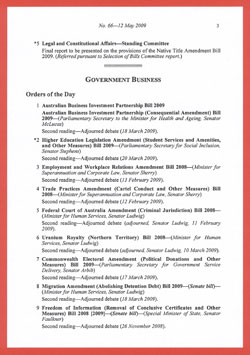65 Government business on Notice Paper
Ministers may arrange the order of their notices of motion and orders of the day on the Notice Paper as they think fit.
Amendment history
Adopted: 19 August 1903 as SO 65
1989 revision: Old SO 69 renumbered as SO 65
Commentary

Government business is listed on the Notice Paper in the order determined by the government
Like SO 56, which allows ministers to move motions at any time without notice in connection with the conduct of the business of the Senate, SO 65 gives ministers an exclusive power to do that which other senators cannot, in the interests of achieving the flexibility necessary to manage the flow of business. It was amended before adoption in the same terms as SO 56, by the removal of a clause which limited the application of the standing order to those days on which government business had precedence. There was no dispute that the power needed to be generally available on all days.[1]
Standing order 65 had its origins in a sessional order adopted on 5 June 1901 in the following terms:
That the right be reserved to His Majesty’s Ministers of placing Government business in the rotation in which it is to be taken.[2]
What the sessional order was intended to mean was teased out in the brief debate by questions from future President, Senator Gould, who queried whether the Government was able to arrange its business as it saw fit when the Senate met or whether it was required to list it on the Notice Paper beforehand. There are echoes of the debate in the language of the standing order as it was later proposed by the Standing Orders Committee, which included Senator Gould among its members. Senator Drake (Prot, Qld), for the Government, confirmed:
They will inform the Clerk beforehand of the order in which they desire that the business shall be taken, and it will appear in that order on the business paper.
Furthermore, it was confirmed that action to rearrange business on the day would require the Senate’s agreement. In practice, this is done either by postponing business under SO 67 or by means of a motion moved by a minister without notice under SO 56.
Used every sitting day, SO 65 has continued to operate without adjustment of any kind. In the 1938 MS, Edwards records that the practice was for the Clerk Assistant (who was responsible for producing the Notice Paper) to consult the Leader of the Government at the end of each day’s sitting as to the order in which government business was to appear for the following day.
Nothing has changed in principle. For many years, the government of the day has issued a forward program for each sitting week which lists the bills (and, occasionally, other business) with which the government is desirous of dealing on each sitting day of that week. This list is used to inform the order in which government business is printed on the Notice Paper. Before that publication is printed for each sitting day, officers of the Senate responsible for producing the Notice Paper take advice from the Manager of Government Business, a role usually undertaken by a government minister, to either confirm or vary the order of business for the following day. While government business notices of motion are usually listed ahead of government business orders of the day, the final disposition is entirely up to the government and may involve alternating between notices of motion and orders of the day as required.